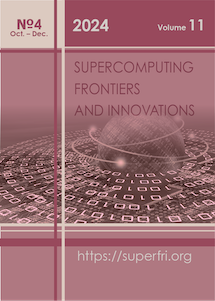A Modification of Adaptive Greedy Algorithm for Solving Problems of Fractured Media Geophysics
DOI:
https://doi.org/10.14529/jsfi240404Keywords:
decomposition, greedy algorithm, large number of grids, large number of fractures, Chimera meshes, patch grids, grid-characteristic method, elastic wave, seismic waveAbstract
Nowadays, the issue of direct modeling of seismic exploration problems is becoming increasingly important due to the development of a new field of application of such algorithms as generation of a training samples for subsequent solution of the appropriate inverse problem using neural networks. This challenges scientists to develop corresponding parallel algorithms and improve their efficiency. The current manuscript is devoted to the algorithm for decomposing a large number of individual computational grids of various sizes for a large number of MPI processes using the example of a 3D direct problem of seismic exploration of geological media treating the complex topology of the Earth’s surface, the complex shape of interfaces between geological layers and a large number of explicitly treated geological fractures, that are not aligned with the coordinate axes. Three modifications of the grid-characteristic numerical method on Chimera and curvilinear computational grids are compared with each other. The dependence on different numbers of fractures is studied. A large number (several hundreds or thousands) of fractures in the geological media significantly increases the amount of transmitted data, which imposes requirements on the developed modification of the greedy algorithm.
References
Badia, S., Mart´ın, A.F., Principe, J.: A highly scalable parallel implementation of balancing domain decomposition by constraints. SIAM Journal on Scientific Computing 36(2), C190–C218 (2014), https://doi.org/10.1007/s11075-022-01268-0
Favorskaya, A., Khokhlov, N.: Accounting for curved boundaries in rocks by using curvilinear and Chimera grids. Procedia Computer Science 192, 3787–3794 (2021), https://doi.org/10.1016/j.procs.2021.09.153
Favorskaya, A., Khokhlov, N., Sagan, V., Podlesnykh, D.: Parallel computations by the grid-characteristic method on Chimera computational grids in 3D problems of railway nondestructive testing. In: Voevodin, V., Sobolev, S., Yakobovskiy, M., Shagaliev, R. (eds.) Supercomputing. RuSCDays 2022, Lecture Notes in Computer Science, vol. 13708, pp. 199–213. Springer, Cham (2022), https://doi.org/10.1007/978-3-031-22941-1_14
Favorskaya, A., Petrov, I., Grinevskiy, A.: Numerical simulation of fracturing in geological medium. Procedia Computer Science 112, 1216–1224 (2017), https://doi.org/10.1016/j.procs.2017.08.042
Favorskaya, A.V., Khokhlov, N.I., Petrov, I.B.: Grid-characteristic method on joint structured regular and curved grids for modeling coupled elastic and acoustic wave phenomena in objects of complex shape. Lobachevskii Journal of Mathematics 41, 512–525 (2020), https://doi.org/10.1134/S1995080220040083
Favorskaya, A.V., Petrov, I.B.: The use of full-wave numerical simulation for the investigation of fractured zones. Mathematical Models and Computer Simulations 11, 518–530 (2019), https://doi.org/10.1134/S2070048219040069
Golubev, V., Nikitin, I., Beklemysheva, K.: Model of fractured medium and nondestructive control of composite materials. Chinese Journal of Aeronautics 37(2), 93–99 (2024), https://doi.org/10.1016/j.cja.2023.11.023
Golubev, V., Nikitin, I., Vasyukov, A., Nikitin, A.: Fractured inclusion localization and characterization based on deep convolutional neural networks. Procedia Structural Integrity 43, 29–34 (2023), https://doi.org/10.1016/j.prostr.2022.12.230
Goncharsky, A.V., Romanov, S.Y., Seryozhnikov, S.Y.: Supercomputer technologies in tomographic imaging applications. Supercomputing Frontiers and Innovations 3(1), 41–66 (2016), https://doi.org/10.14529/jsfi160103
Hall, F., Wang, Y.: Seismic response of fractures by numerical simulation. Geophysical Journal International 189(1), 591–601 (2012), https://doi.org/10.1111/j.1365-246X.2012.05360.x
Henshaw, W.D., Schwendeman, D.W.: Parallel computation of three-dimensional flows using overlapping grids with adaptive mesh refinement. Journal of Computational Physics 227(16), 7469–7502 (2008), https://doi.org/10.1016/j.jcp.2008.04.033
Khokhlov, N., Favorskaya, A., Stetsyuk, V., Mitskovets, I.: Grid-characteristic method using Chimera meshes for simulation of elastic waves scattering on geological fractured zones. Journal of Computational Physics 446, 110637 (2021), https://doi.org/10.1016/j.jcp.2021.110637
Khokhlov, N.I., Favorskaya, A.V., Furgailo, V.: Grid-characteristic method on overlapping curvilinear meshes for modeling elastic waves scattering on geological fractures. Minerals 12(12), 1597 (2022), https://doi.org/10.3390/min12121597
Micucci, M., Iula, A.: Recent advances in machine learning applied to ultrasound imaging. Electronics 11(11), 1800 (2022), https://doi.org/10.3390/electronics11111800
Muratov, M., Ryazanov, V., Biryukov, V., Petrov, D., Petrov, I.: Inverse problems of heterogeneous geological layers exploration seismology solution by methods of machine learning. Lobachevskii Journal of Mathematics 42(7), 1728–1737 (2021), https://doi.org/10.1134/S1995080221070180
Pleshkevich, A.L., Ivanov, A.V., Levchenko, V.D., et al.: Efficient parallel implementation of multi-arrival 3D prestack seismic depth migration. Supercomputing Frontiers and Innovations 6(1), 4–8 (2019), https://doi.org/10.14529/jsfi190101
Qi, Y., Chen, X., Zhao, Q., et al.: Seismic wave modeling of fluid-saturated fractured porous rock: including fluid pressure diffusion effects of discretely distributed large-scale fractures. Solid Earth 15(4), 535–554 (2024), https://doi.org/10.5194/se-15-535-2024
Rybakin, B., Goryachev, V.: Heterogeneous computing systems in problems of modeling filaments formation and pre-stellar objects. In: Voevodin, V., Sobolev, S., Yakobovskiy, M., Shagaliev, R. (eds.) Supercomputing. RuSCDays 2022, Lecture Notes in Computer Science, vol. 13708, pp. 127–139. Springer, Cham (2022), https://doi.org/10.1007/978-3-031-22941-1_9
Schoenberg, M.: Elastic wave behavior across linear slip interfaces. The Journal of the Acoustical Society of America 68(5), 1516–1521 (1980), https://doi.org/10.1121/1.385077
Vamaraju, J., Sen, M.K., De Basabe, J., Wheeler, M.: A hybrid Galerkin finite element method for seismic wave propagation in fractured media. Geophysical Journal International 221(2), 857–878 (2020), https://doi.org/10.1093/gji/ggaa037
Wang, K., Peng, S., Lu, Y., Cui, X.: The velocity-stress finite-difference method with a rotated staggered grid applied to seismic wave propagation in a fractured medium. Geophysics 85(2), T89–T100 (2020), https://doi.org/10.1190/geo2019-0186.1
Xiang, Y., Wang, Z., Song, Z., et al.: Seismictransformer: An attention-based deep learning method for the simulation of seismic wavefields. Computers & Geosciences p. 105629 (2024), https://doi.org/10.1016/j.cageo.2024.105629
Xu, J., Hu, H., Liu, Q.H., Zhan, Q., Zhuang, M.: Spectral element modeling of elastic wave propagation in an anisotropic background with discrete anisotropic fractures. Geophysical Journal International 227(2), 832–848 (2021), https://doi.org/10.1093/gji/ggab226
Xu, Y., Chen, X., Zhang, W., Pan, X.: An adaptive modal discontinuous Galerkin finite element parallel method using unsplit multi-axial perfectly matched layer for seismic wave modeling. Commun. Comput. Phys. 31(4), 1083–1113 (2022). https://doi.org/10.4208/cicp.OA-2021-0118
Downloads
Published
How to Cite
Issue
License
Authors retain copyright and grant the journal right of first publication with the work simultaneously licensed under a Creative Commons Attribution-Non Commercial 3.0 License that allows others to share the work with an acknowledgement of the work's authorship and initial publication in this journal.

